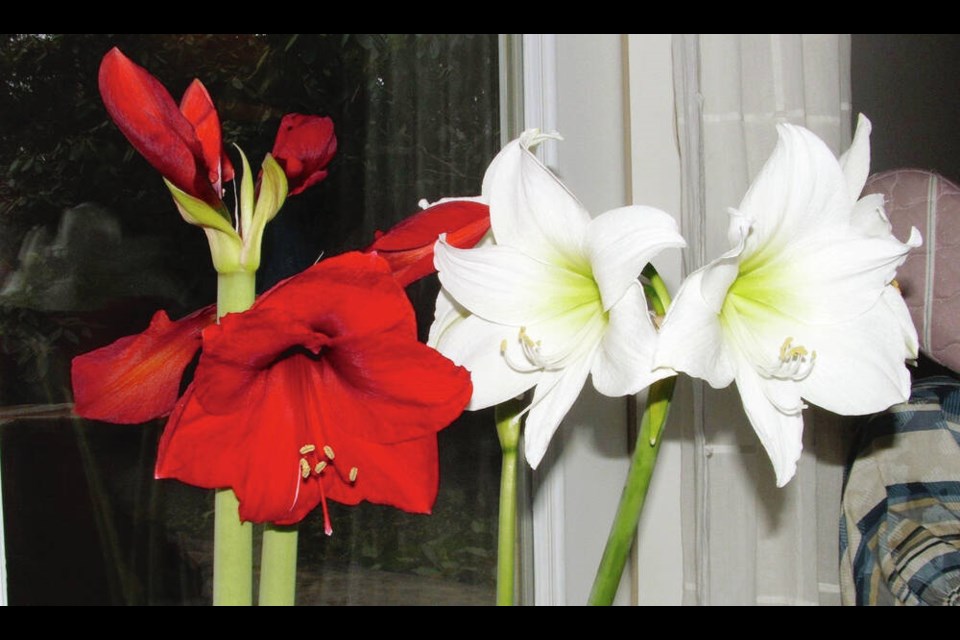Dear Helen: Last year my amaryllis bloomed well. After the flowering period, I thought the leaves would just die off, but they did not. They are now over 60 cm long. Will the plant bloom again? Should I cut off the leaves?
M.L.
The leaves don’t die down naturally. The traditional method of managing an amaryllis bulb after it has flowered is, first of all, to remove the faded flowers and then, to re-build the bulb for another season of bloom, to water regularly. The idea is to keep the foliage growing as robustly as possible.
It is helpful, where possible, to place the pot outdoors in filtered sun or light shade, for the summer. Water regularly and fertilize every two weeks with a solution mixed at half the recommended label strength.
Stop watering the plant in late September and bring it indoors when overnight temperatures begin dipping below 10 C. The leaves will begin dying down. Remove them once they are dry, and store the pot in a cool (10 to 14 C), dark place for at least eight to 10 weeks.
After this “rest” period, or when the first nub of growth appears (whichever happens first), bring the pot into room temperatures, replace a top layer of potting mix with fresh, and water. Repotting is usually necessary only every two or three years.
As growth emerges, place the pot in bright indirect light. To help keep a growing flower stalk straight, give the pot a quarter turn clockwise, weekly.
An alternative: This, most often used, method for handling amaryllis bulbs is aimed at producing the next round of flowers as close to the holiday season as possible. Some people do not bother with a dormancy period and, like you, elect to keep the plants green and growing year-round and enjoy the flowers when they emerge, usually in spring to early summer.
Over time and as offset bulbs emerge, a planting can become a mass of green leaves with a yearly display of sometimes several flowering stalks. I’ve heard descriptions of amaryllis plantings that had never been forced into dormancy but kept as green plants year found, with the occasional yellowed leaves clipped off after they had dried.
Offsets that developed were left in the plantings, and the entire clumps were moved on to bigger pots as needed. One planting was described, at the time of viewing it, as having eight stalks bearing red flowers all at once.
Most amaryllis bulbs will eventually produce small baby bulbs alongside the “mother” bulb. If you are not keen to develop a clump of bulbs, these bulblets can be separated from the mother bulb and potted individually to grow, over several years, into flowering size bulbs.
Dear Helen: I am dismayed at the number of blue medical masks left lying about, and wonder whether they might have some gardening use. Could they be placed over drainage holes in pots before filling the pots with soil, and could the elastic parts serve as plant ties?
J.L.
It is distressing to see so many discarded blue medial masks not disposed of properly. Unfortunately, they are not recyclable or biodegradable and must be placed in the garbage.
Last year, thanks to a tip from a reader, I began pulling the elastic ear loops from my used masks and began securing tomato and other vines to their supports with them.
As for using the mask materials in potting, I think a word of caution is in order. I’m not a medical person, but common sense would suggest using masks that only healthy family members have worn out in public as prevention against infection. Avoid touching or using masks that have just been “found.”
To answer your question, I separated one of my blue masks into its three layers and tested their permeability under running water. The middle, filter cloth layer did not let water through while the inner, gauze-like layer and the blue outer layer (described as “fluid-repellent”) both let water drain through.
The outer and inner layers could be used to cover pot drainage holes, but then you’re still left with a disposal issue. Still, at least the material would have had a second use before being placed in the garbage.
Holiday time. I’ll be celebrating the new year’s arrival with a rest period. I’ll be back on Wednesday, Jan. 10. Happy New Year!



